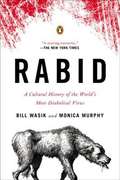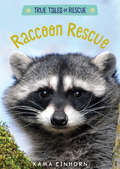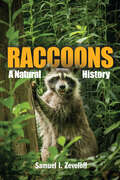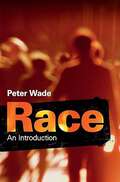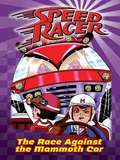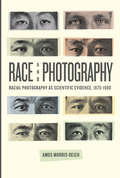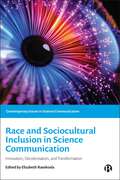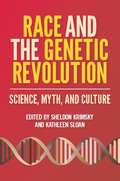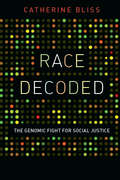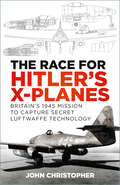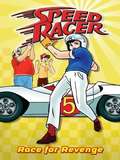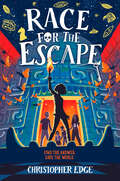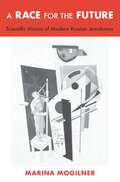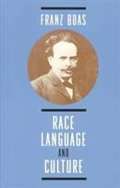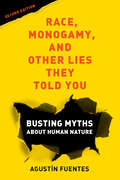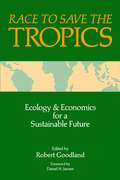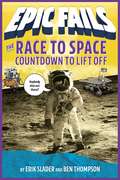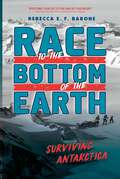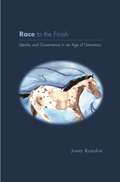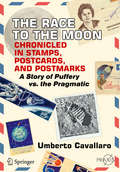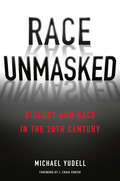- Table View
- List View
Rabid: A Cultural History of the World's Most Diabolical Virus
by Bill Wasik Monica MurphyA maddened creature, frothing at the mouth, lunges at an innocent victim—and, with a bite, transforms its prey into another raving monster. It’s a scenario that underlies our darkest tales of supernatural horror, but its power derives from a very real virus, a deadly scourge known to mankind from our earliest days. In this fascinating exploration, journalist Bill Wasik and veterinarian Monica Murphy chart four thousand years in the history, science, and cultural mythology of rabies. The most fatal virus known to science, rabies kills nearly 100 percent of its victims once the infection takes root in the brain. A disease that spreads avidly from animals to humans, rabies has served throughout history as a symbol of savage madness, of inhuman possession. And today, its history can help shed light on the wave of emerging diseases, from AIDS to SARS to avian flu, that we now know to originate in animal populations. From Greek myths to zombie flicks, from the laboratory heroics of Louis Pasteur to the contemporary search for a lifesaving treatment, Rabid is a fresh, fascinating, and often wildly entertaining look at one of mankind’s oldest and most fearsome foes. .
Raccoon Rescue (True Tales of Rescue)
by Kama EinhornWhat is life like for a group of orphaned raccoon siblings, born in the attic of a home, as they experience life at a raccoon rehabilitation center in California? This photo‑packed series explores the stories and science behind animal sanctuaries, including all of the ups and downs that go along with caring for wild raccoons away from their natural element. Includes full‑color photos, graphics, and maps. At WildCare in San Rafael, California, many wild animals are brought in every day – skunks, birds, opossums, squirrels, and more – including raccoons. Four baby raccoons are put into the hands of WildCare staff, specifically volunteer Shelley. The kits need feedings, medicine, burpings, and even help going to the bathroom. The kits are not allowed to spend any time with other humans – they can’t be used to humans once they are returned to the wilds of suburbia. A steady process involving enrichment, exercise, outdoor exposure– and more than you’ll ever think you’ll know about raccoons and other city wildlife – fills the pages of Raccoon Rescue.
Raccoons: A Natural History
by Samuel I. ZeveloffThe word raccoon is drawn from the Native American Algonquian language. Their term arakun roughly translates to "he who scratches with his hands." Anyone who has found a raccoon rummaging around in a once securely closed trash container can attest to how skillful raccoons are with their front paws. In fact, they have four times as many sensory receptors in their forepaw skin as they do in their hindpaws, a ratio similar to that of human hands and feet. Samuel Zeveloff explores this trait and much more in his accessible natural history of raccoons.Written with the general reader in mind, Raccoons presents detailed information on raccoon evolution, physical characteristics, social behavior, habitats, food habits, reproduction, and conservation, as well as their relationship with humans and many other topics. The section on distribution and subspecies focuses on the raccoon's current range expansion, and the material on their cultural significance demonstrates this mammal's unique status in different North American cultures.
Raccoons and Their Relatives (World Book's Animals of the World)
by Pat Harvey SullivanDo raccoons wear masks? What's special about a raccoon's "hands"? Do raccoons wash their food? Do raccoons hibernate in winter? Find out all about the physical characteristics, habits, and behavior of raccoons and such related species as the coati, kinkajou, red panda, and ringtail.
Race
by Peter WadeTaking a comparative approach, this textbook is a concise introduction to race. Illustrated with detailed examples from around the world, it is organised into two parts. Part One explores the historical changes in ideas about race from the ancient world to the present day, in different corners of the globe. Part Two outlines ways in which racial difference and inequality are perceived and enacted in selected regions of the world. Examining how humans have used ideas of physical appearance, heredity and behaviour as criteria for categorising others, the text guides students through provocative questions such as: what is race? Does studying race reinforce racism? Does a colour-blind approach dismantle, or merely mask, racism? How does biology feed into concepts of race? Numerous case studies, photos, figures and tables help students to appreciate the different meanings of race in varied contexts, and end-of-chapter research tasks provide further support for student learning.
Race Against the Mammoth Car, The #4
by Chase WheelerSpeed has entered the No Limit World Race, but the competition is overshadowed by the theft of $50 million in gold bars. Can Speed and Racer X solve the crime before they reach the finish line?
Race and Membership In American History: The Eugenics Movement
by Facing History Ourselves National Foundation Inc.Focuses on a time in the early 1900's when many people believed that some "races", classes and individuals were superior to others. A new branch of scientific inquiry known as Eugenics was used to justify these prejudices and advocate programs and policies aimed at solving the nation's problems by ridding society of "inferior racial traits".
Race and Photography
by Amos Morris-ReichRace and Photography studies the changing function of photography from the 1870s to the 1940s within the field of the "science of race," what many today consider the paradigm of pseudo-science. Amos Morris-Reich looks at the ways photography enabled not just new forms of documentation but new forms of perception. Foregoing the political lens through which we usually look back at race science, he holds it up instead within the light of the history of science, using it to explore how science is defined; how evidence is produced, used, and interpreted; and how science shapes the imagination and vice versa. Exploring the development of racial photography wherever it took place, including countries like France and England, Morris-Reich pays special attention to the German and Jewish contexts of scientific racism. Through careful reconstruction of individual cases, conceptual genealogies, and patterns of practice, he compares the intended roles of photography with its actual use in scientific argumentation. He examines the diverse ways it was used to establish racial ideologies--as illustrations of types, statistical data, or as self-evident record of racial signs. Altogether, Morris-Reich visits this troubling history to outline important truths about the roles of visual argumentation, imagination, perception, aesthetics, epistemology, and ideology within scientific study.
Race and Sociocultural Inclusion in Science Communication: Innovation, Decolonisation, and Transformation
by Elizabeth RasekoalaChapter 12 is available Open Access under CC-BY-NC-ND licence. Conversations around diversity, equity, and inclusion in science communication are in danger of generating much concern without effecting change and systematic transformations. This radical volume addresses these circular discourses and reveals the gaps in the field. Putting the spotlight on the marginalised voices of so-called 'racialised minorities', and those from Global South regions, it interrogates the global footprint of the science communication enterprise. Moving beyond tokenistic and extractive approaches, this book creates a space for academics and practitioners to challenge issues around race and sociocultural inclusion, providing mutual learning, paradigm-shifting perspectives, and innovative ways forward for the science communication advancement agenda.
Race and the Genetic Revolution: Science, Myth, and Culture
by Kathleen Sloan Sheldon KrimskyDo advances in genomic biology create a scientific rationale for long-discredited racial categories? Leading scholars in law, medicine, biology, sociology, history, anthropology, and psychology examine the impact of modern genetics on the concept of race. Contributors trace the interplay between genetics and race in forensic DNA databanks, the biology of intelligence, DNA ancestry markers, and racialized medicine. Each essay explores commonly held and unexamined assumptions and misperceptions about race in science and popular culture.This collection begins with the historical origins and current uses of the concept of "race" in science. It follows with an analysis of the role of race in DNA databanks and racial disparities in the criminal justice system. Essays then consider the rise of recreational genetics in the form of for-profit testing of genetic ancestry and the introduction of racialized medicine, specifically through an FDA-approved heart drug called BiDil, marketed to African American men. Concluding sections discuss the contradictions between our scientific and cultural understandings of race and the continuing significance of race in educational and criminal justice policy.
Race Decoded: The Genomic Fight for Social Justice
by Catherine BlissIn 2000, with the success of the Human Genome Project, scientists declared the death of race in biology and medicine. But within five years, many of these same scientists had reversed course and embarked upon a new hunt for the biological meaning of race. Drawing on personal interviews and life stories,Race Decodedtakes us into the world of elite genome scientists-including Francis Collins, director of the NIH; Craig Venter, the first person to create a synthetic genome; and Spencer Wells, National Geographic Society explorer-in-residence, among others-to show how and why they are formulating new ways of thinking about race. In this original exploration, Catherine Bliss reveals a paradigm shift, both at the level of science and society, from colorblindness to racial consciousness. Scientists have been fighting older understandings of race in biology while simultaneously promoting a new grand-scale program of minority inclusion. In selecting research topics or considering research design, scientists routinely draw upon personal experience of race to push the public to think about race as a biosocial entity, and even those of the most privileged racial and social backgrounds incorporate identity politics in the scientific process. Though individual scientists may view their positions differently-whether as a black civil rights activist or a white bench scientist-all stakeholders in the scientific debates are drawing on memories of racial discrimination to fashion a science-based activism to fight for social justice.
The Race for Hitler's X-Planes: Britain's 1945 Mission to Capture Secret Luftwaffe Technology
by John ChristopherDuring World War 2, Hitler’s engineers had pioneered an incredible array of futuristic secret weapons, from the Me 262, the first operational jet fighter, to the deadly V2 inter continental ballistic missile. With the Third Reich shattered and lying in ruins, in the summer of 1945, the Allies launched a frantic race to grab what they saw as the justifiable spoils of war. The Americans and Russians in particular were anxious to secure not only the aircraft and the research and production facilities, but also the key German scientists and engineers.This Nazi technology would define the balance of power in the phoney peace of the Cold War era, launching an arms race that shaped our modern world for decades to come. But what of Britain’s role in this supermarket sweep? The Race for Hitler’s X-Planes tells the untold story of the British mission to Germany.
Race for Revenge #6
by Chase WheelerWhen several cars are run off the road, Speed starts looking for answers. But Speed gets more than he bargained for when he learns about a driver who is out for revenge... and who won't stop until he gets it!
Race for the Escape
by Christopher EdgeFive kids. One ultimate escape room. Can they solve it--or will they die trying? From the award-winning author of The Many World of Albie Bright comes a brand-new adventure that will having you racing to finish. When Ami Oswald arrives at The Escape--a new, supposedly impossible-to-beat escape room--all she wants it an evening of adventure for her birthday. She deserves it, after all her hard work. But as soon as the game starts, Ami and her four teammates realize they may have gotten more than they bargained for. Now, the only way Ami and her friends can get out is by solving the mysterious riddle the Escape's Host has given them: Find the Answer, save the world. But the Answer could be anywhere, and in this game, a single mistake could be deadly. Because, as Ami quickly finds out, the danger in these rooms is very, very real. Join Ami and the rest of the Five Mind as they face ancient Mayan warriors, a sinister library, and even prehistoric beasts in their quest to find the Answer and save the world, before it's too late. Can you escape the Escape? The world is betting on your success...
A Race for the Future: Scientific Visions of Modern Russian Jewishness
by Marina MogilnerThe forgotten story of a surprising anti-imperial, nationalist project at the turn of the twentieth century: a grassroots movement of Russian Jews to racialize themselves.In the rapidly nationalizing Russian Empire of the late nineteenth century, Russian Jews grew increasingly concerned about their future. Jews spoke different languages and practiced different traditions. They had complex identities and no territorial homeland. Their inability to easily conform to new standards of nationality meant a future of inevitable assimilation or second-class minority citizenship. The solution proposed by Russian Jewish intellectuals was to ground Jewish nationhood in a structure deeper than culture or territory—biology.Marina Mogilner examines three leading Russian Jewish race scientists— Samuel Weissenberg, Alexander El’kind, and Lev Shternberg—and the movement they inspired. Through networks of race scientists and political activists, Jewish medical societies, and imperial organizations like the Society for the Protection of the Health of the Jewish Population, they aimed to produce “authentic” knowledge about the Jewish body, which would motivate an empowering sense of racially grounded identity and guide national biopolitics. Activists vigorously debated eugenic and medical practices, Jews’ status as Semites, Europeans, and moderns, and whether the Jews of the Caucasus and Central Asia were inferior. The national science, and the biopolitics it generated, became a form of anticolonial resistance, and survived into the early Soviet period, influencing population policies in the new state.Comprehensive and meticulously researched, A Race for the Future reminds us of the need to historically contextualize racial ideology and politics and makes clear that we cannot fully grasp the biopolitics of the twentieth century without accounting for the imperial breakdown in which those politics thrived.
Race, Language and Culture
by Franz BoasThis volume is a collection of the most important essays written by Franz Boas on the science of anthropology. <p><p> "Franz Boas is the father of American anthropology and one of the founders of the field of modern anthropology. The book, Race, Language, and Culture, is a collection of some of his most important essays."—David Schneider, University of Chicago<p> "An exceptional book. Exceptional because it brings into one volume sixty-two papers written by the most influential figure in American anthropology. . . . Exceptional in that it exhibits the wide range of interests and scientific exactness which made it possible for one man to exert such a profound influence on the growing science of anthropology. . . . This is a volume every student of anthropology will wish to possess; it will also have a wide distribution among other students of the social sciences, and all interested in the problems of race."—Fay-Cooper Cole, American Anthropologist
Race, Monogamy, and Other Lies They Told You, Second Edition: Busting Myths about Human Nature
by Agustín FuentesA compelling takedown of prevailing myths about human behavior, updated and expanded to meet the current moment. There are three major myths of human nature: humans are divided into biological races; humans are naturally aggressive; and men and women are wholly different in behavior, desires, and wiring. Race, Monogamy, and Other Lies They Told You counters these pervasive and pernicious myths about human behavior. Agustín Fuentes tackles misconceptions about what race, aggression, and sex really mean for humans, and incorporates an accessible understanding of culture, genetics, and evolution that requires us to dispose of notions of "nature or nurture." Presenting scientific evidence from diverse fields, including anthropology, biology, and psychology, Fuentes devises a myth-busting toolkit to dismantle persistent fallacies about the validity of biological races, the innateness of aggression and violence, and the nature of monogamy, sex, and gender. This revised and expanded edition provides up-to-date references, data, and analyses, and addresses new topics, including the popularity of home DNA testing kits and the lies behind ‘"incel" culture; the resurgence of racist, nativist thinking and the internet's influence in promoting bad science; and a broader understanding of the diversity of sex and gender.
Race to Save the Tropics: Ecology And Economics For A Sustainable Future
by Dan Janzen Robert GoodlandRace to Save the Tropics documents the conflict between economic development and protection of biological diversity in tropical countries.
The Race to Space: Countdown To Liftoff (Epic Fails #2)
by Ben Thompson Erik Slader Tim FoleyIn this second installment of the Epic Fails series, explore the many failures that made up the Space Race, paving the way for humanity’s eventual success at reaching the stars.Today, everyone is familiar with Neil Armstrong’s famous words as he first set foot on the moon: “one small step for man; one giant leap for mankind.” He made it look easy, but America’s journey to the moon was anything but simple. In 1957, when the Soviet Union launched Sputnik, the world’s first satellite, into orbit, America had barely crossed the starting line of the great Space Race. Later that year, our first attempt was such a failure that the media nicknamed it “Kaputnik.” Still, we didn’t give up. With each failure, we gleaned valuable information about what went wrong, and how to avoid it in the future. So we tried again. And again. And each time we failed, we failed a little bit better.The Epic Fails series by Erik Slader and Ben Thompson explores the humorous backstories behind a variety of historical discoveries, voyages, experiments, and innovations that didn't go as expected but succeeded nonetheless, showing that many of mankind's biggest success stories are the result of some pretty epic failures indeed.
Race to the Bottom of the Earth: Surviving Antarctica
by Rebecca E. BaroneEqual parts adventure and STEM, Rebecca E. F. Barone's Race to the Bottom of the Earth: Surviving Antarctica is a thrilling nonfiction book for young readers chronicling two treacherous, groundbreaking expeditions to the South Pole—and includes eye-catching photos of the Antarctic landscape."Riveting! I raced to the end of this book!" —Alan Gratz, New York Times bestselling author of Refugee In 1910, Captain Robert Scott prepared his crew for a trip that no one had ever completed: a journey to the South Pole. He vowed to get there any way he could, even if it meant looking death in the eye. Then, not long before he set out, another intrepid explorer, Roald Amundsen, set his sights on the same goal. Suddenly two teams were vying to be the first to make history—what was to be an expedition had become a perilous race.In 2018, Captain Louis Rudd readied himself for a similarly grueling task: the first unaided, unsupported solo crossing of treacherous Antarctica. But little did he know that athlete Colin O’Brady was training for the same trek—and he was determined to beat Louis to the finish line. For fans of Michael Tougias’ The Finest Hours, this gripping account of two history-making moments of exploration and competition is perfect for budding scientists, survivalists, and thrill seekers."A nail-biting tale of adventure, tragedy, and superhuman determination—and also a luminous example of how our present lives are shaped by our immeasurably deep connection to our past." —Elizabeth Wein, #1 New York Times bestselling author of Code Name Verity "A huge treat for adventure story fans—not one, but two incredible races across the fearsome and fascinating Antarctic!" —Steve Sheinkin, New York Times bestselling author of Bomb and Undefeated
Race to the Finish: Identity and Governance in an Age of Genomics (In-Formation)
by Jenny ReardonIn the summer of 1991, population geneticists and evolutionary biologists proposed to archive human genetic diversity by collecting the genomes of "isolated indigenous populations." Their initiative, which became known as the Human Genome Diversity Project, generated early enthusiasm from those who believed it would enable huge advances in our understanding of human evolution. However, vocal criticism soon emerged. Physical anthropologists accused Project organizers of reimporting racist categories into science. Indigenous-rights leaders saw a "Vampire Project" that sought the blood of indigenous people but not their well-being. More than a decade later, the effort is barely off the ground. How did an initiative whose leaders included some of biology's most respected, socially conscious scientists become so stigmatized? How did these model citizen-scientists come to be viewed as potential racists, even vampires? This book argues that the long abeyance of the Diversity Project points to larger, fundamental questions about how to understand knowledge, democracy, and racism in an age when expert claims about genomes increasingly shape the possibilities for being human. Jenny Reardon demonstrates that far from being innocent tools for fighting racism, scientific ideas and practices embed consequential social and political decisions about who can define race, racism, and democracy, and for what ends. She calls for the adoption of novel conceptual tools that do not oppose science and power, truth and racist ideologies, but rather draw into focus their mutual constitution.
The Race to the Moon Chronicled in Stamps, Postcards, and Postmarks: A Story of Puffery vs. the Pragmatic (Springer Praxis Books)
by Umberto CavallaroThe story of the famed race to the Moon between the US and the USSR has been told countless times. The strategies of these two superpowers have often been paralleled in a way that highlights their fight for dominance and efforts to develop needed new technologies. This book will show how beneath these surface similarities, the two competing nations employed very different core tactics. It provides a new perspective of the history of the space race by analyzing that history through philately - that is, from the images on postage stamps, post cards, and letters in circulation at that time. Through this fascinating historical visual record, the author shows how the propaganda-heavy approach of the USSR eventually lost out to the more pragmatic approach of the United States.
Race Unmasked: Biology and Race in the Twentieth Century (Race, Inequality, and Health #6)
by Michael YudellRace, while drawn from the visual cues of human diversity, is an idea with a measurable past, an identifiable present, and an uncertain future. The concept of race has been at the center of both triumphs and tragedies in American history and has had a profound effect on the human experience. Race Unmasked revisits the origins of commonly held beliefs about the scientific nature of racial differences, examines the roots of the modern idea of race, and explains why race continues to generate controversy as a tool of classification even in our genomic age.Surveying the work of some of the twentieth century's most notable scientists, Race Unmasked reveals how genetics and related biological disciplines formed and preserved ideas of race and, at times, racism. A gripping history of science and scientists, Race Unmasked elucidates the limitations of a racial worldview and throws the contours of our current and evolving understanding of human diversity into sharp relief.
Race Unmasked
by Michael YudellExploring the role of science in the making of America's modern racial calculus.
Race Unmasked
by Michael YudellExploring the role of science in the making of America's modern racial calculus.
